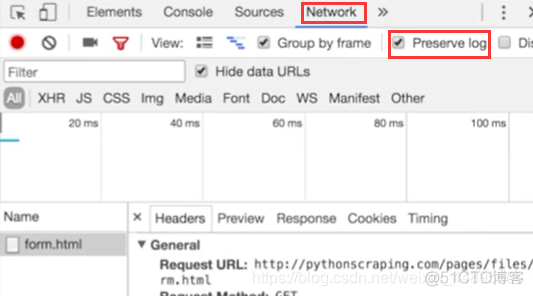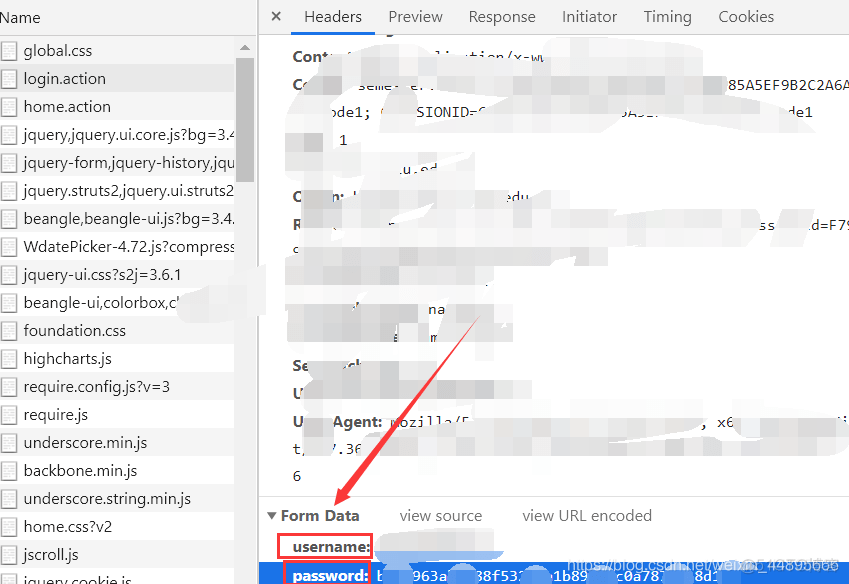文章目录
这些知识的学习来源于网课,网课连接: https://www.youtube.com/playlist?list=PLXO45tsB95cIuXEgV-mvYWRd_hVC43Akk
背景知识
爬虫需要一部分网页相关知识,可以在这里充电:HTML, JS
简单爬虫示例
思路描述:打开网页之后,根据正则表达式选择待查找的内容。然后将结果输出。
# -*- coding: utf-8 -*-
“””
@author: kingdeguo
“””
from urllib.request import urlopen
# 导入正则表达库
import re
# 使用库函数爬取整个页面
html = urlopen(
“https://blog.csdn.net/weixin_44895666”
).read().decode(“utf-8”)
# print(html)
# 接下来可以使用正则表达式选择需要的信息进行爬取
title = re.findall(r”<title>(.+?)</title>”, html)
print(“\n Page title is :”, title[0]) 使用BeautifulSoup
但是这样的方式有些繁琐,推荐使用BeautifulSoup模块。BeautifulSoup用来简化匹配过程。
注意需要安装BeautifulSoup和lxml
pip install BeautifulSoup4
pip install lxml
也可以不安装lxml使用Python内置的解析器html.parser
其他部分解释见注释
爬取网页标题示例
# -*- coding: utf-8 -*-
“””
@author: kingdeguo
“””
from bs4 import BeautifulSoup
from urllib.request import urlopen
html = urlopen(“https://blog.csdn.net/weixin_44895666”).read().decode(“utf-8”)
# print(html)
# 首先需要把整个网页中的内容给BeautifulSoup
# 然后选择解析器,这里选择的解析器是lxml
# soup = BeautifulSoup(html, “html.parser”)
soup = BeautifulSoup(html, “lxml”)
# 对于想要输出的内容,按照 .tagname 的方式即可
# 可以多级访问
print(soup.head.title)
爬取网页中所有超链接示例
下面的示例尝试找出网页中的所有超链接
# 找出所有的超链接
all_href = soup.find_all(‘a’)
# 注意此时打印出来的不是超链接,而是字典。
# print(all_href)
# 需要把标签去掉,相当于根据key获取value
try:
for l in all_href:
print(l[‘href’])
except:
print(“mismatch”)
爬取CSS中class内容
因为class往往都是存放了相关的信息,所以对该部分进行爬取会比较高效。
# -*- coding: utf-8 -*-
“””
@author: Kingdeguo
“””
from bs4 import BeautifulSoup
from urllib.request import urlopen
html = urlopen(“https://blog.csdn.net/weixin_44895666”).read().decode(“utf-8”)
soup = BeautifulSoup(html, “lxml”)
# 选择class属性
all_info = soup.find_all(‘div’, {‘class’:’title-box’})
print(all_info)
使用正则表达爬取所有JPG图片相关连接
from bs4 import BeautifulSoup
from urllib.request import urlopen
import re
# 使用库函数爬取整个页面
html = urlopen(
“https://blog.csdn.net/weixin_44895666”
).read().decode(“utf-8”)
# print(html)
soup = BeautifulSoup(html, “lxml”)
img_links = soup.find_all(“img”, {“src”:re.compile(‘.*?\.jpg’)});
for link in img_links:
print(link[‘src’])
爬取百度百科
首先打开一个网页,然后在这个网页中寻找连接,然后从找到的子链接中随便选一个继续爬取。
from bs4 import BeautifulSoup
from urllib.request import urlopen
import re
import random
base_url = “https://baike.baidu.com”
his = [“/item/%E8%AE%A1%E7%AE%97%E6%9C%BA”]
for i in range(10):
try:
url = base_url + his[-1]
html = urlopen(url).read().decode(“utf-8”)
soup = BeautifulSoup(html, “lxml”)
print(i, ” “, soup.find(‘h1’).get_text(), ‘ url: ‘, his[-1])
sub_urls = soup.find_all(“a”,{“target”:”_blank”, “href”:re.compile(“/item/(%.{2})+$”)})
if len(sub_urls) != 0:
his.append(random.sample(sub_urls, 1)[0][‘href’])
else:
his.pop()
except:
print(“Can’t open!”)
使用requests
# 打印出来URL
import requests
# 下面的字典中存放的是参数
param = {“q”:”kingdeguo”}
r = requests.get(“https://www.google.com/search”, params=param)
print(r.url)
# 将会输出 https://www.google.com/search?q=kingdeguo
如果导入webbrowser模块,则可以直接使用代码用电脑默认浏览器打开这个网址。
import requests
import webbrowser
param = {“q”:”kingdeguo”}
r = requests.get(“https://www.google.com/search”, params=param)
print(r.url)
webbrowser.open(r.url)
接下来学习使用requests进行登录。因为有些网站,比如知乎,在登录前和登录后的显示是不一样的,这样可能会影响到之后的爬取。


这里可以找到POST的表单数据的属性名称。然后按照下面的格式书写即可。
import requests
data = {“username”:”username”, “password”:”password”}
r = requests.post(“https://***”, data = data)
print(r.text)
通拓POST一张本地图片来使用百度识图功能。
import requests
import webbrowser
file = {“sign”:open(“./1.jpg”, “rb”)}
r = requests.post(
“https://graph.baidu.com/s”,
files = file
)
print(r.text)
使用Cookie
import requests
payload = {“uid”:””, “upw”:””}
r = requests.post(“https://***”, data = payload)
print(r.cookies.get_dict())
r = requests.get(“https://***”, cookies = r.cookies)
print(r.text)
使用session
import requests
session = requests.Session()
payload = {“uid”:””, “upw”:””}
r = session.post(“https://***”, data = payload)
print(r.cookies.get_dict())
# 这里的session已经包含了cookie的信息
r = session.get(“https://***”, data = payload)
print(r.text)
下载文件
import os
os.makedirs(‘./img/’, exist_ok=True)
IMAGE_URL = ‘https://avatar.csdnimg.cn/C/8/C/3_weixin_44895666_1568427141.jpg’
# 方式1
from urllib.request import urlretrieve
urlretrieve(IMAGE_URL, ‘./img/image.jpg’)
# 方式2
import requests
r = requests.get(IMAGE_URL)
with open(‘./img/image2.jpg’,’wb’) as f:
f.write(r.content)
# 方式3
# 适合比较大的文件,比如电影等
r = requests.get(IMAGE_URL, stream=True)
with open(‘./img/image3.jpg’,’wb’) as f:
for chunk in r.iter_content(chunk_size=32):
f.write(chunk) 多线程分布式
如果不适用多线程来处理,一般是按照如下的顺序方式来处理,通过循环来进行多次处理。
import multiprocessing as mp
import re
from urllib.request import urlopen,urljoin
from bs4 import BeautifulSoup
import re
import time
base_url = “https://mofanpy.com/”
def crawl(url):
response = urlopen(url)
time.sleep(0.1)
return response.read().decode()
def parse(html):
soup = BeautifulSoup(html, “lxml”)
urls = soup.find_all(‘a’, {“href”:re.compile(‘^/.+?/$’)})
title = soup.find(‘h1’).get_text().strip()
page_urls = set([urljoin(base_url, url[‘href’]) for url in urls])
url = soup.find(‘meta’,{‘property’:’og:url’})[‘content’]
return title, page_urls, url
unseen = set([base_url,])
seen = set()
count , t1 = 1, time.time()
while len(unseen)!=0:
if len(seen) > 20:
break;
print(“Crawing”)
htmls = [crawl(url) for url in unseen]
print(“parsing”)
results = [parse(html) for html in htmls]
print(“ananyisc”)
seen.update(unseen)
unseen.clear()
for title, page_urls, url in results:
count += 1
unseen.update(page_urls – seen)
print(“total time:%.1f ” % (time.time()-t1), )
加入线程池之后,可以使用多线程方式进行处理
import multiprocessing as mp
import re
from urllib.request import urlopen,urljoin
from bs4 import BeautifulSoup
import re
import time
base_url = “https://mofanpy.com/”
def crawl(url):
response = urlopen(url)
time.sleep(0.1)
return response.read().decode()
def parse(html):
soup = BeautifulSoup(html, “lxml”)
urls = soup.find_all(‘a’, {“href”:re.compile(‘^/.+?/$’)})
title = soup.find(‘h1’).get_text().strip()
page_urls = set([urljoin(base_url, url[‘href’]) for url in urls])
url = soup.find(‘meta’,{‘property’:’og:url’})[‘content’]
return title, page_urls, url
unseen = set([base_url,])
seen = set()
# 增加线程池
pool = mp.Pool(4)
count , t1 = 1, time.time()
while len(unseen)!=0:
if len(seen) > 10:
break;
print(“Crawing”)
# 新增部分
crawl_jobs = [pool.apply_async(crawl, args=(url, )) for url in unseen]
htmls = [j.get() for j in crawl_jobs]
# htmls = [crawl(url) for url in unseen]
print(“parsing”)
parse_jobs = [pool.apply_async(parse, args=(html, )) for html in htmls]
results = [j.get() for j in parse_jobs]
# results = [parse(html) for html in htmls]
print(“ananyisc”)
seen.update(unseen)
unseen.clear()
for title, page_urls, url in results:
count += 1
unseen.update(page_urls – seen)
print(“total time:%.1f ” % (time.time()-t1), )
神龙|纯净稳定代理IP免费测试>>>>>>>>天启|企业级代理IP免费测试>>>>>>>>IPIPGO|全球住宅代理IP免费测试





